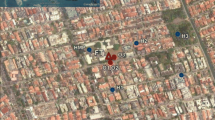Abstract
Observations show that the urban heat island in the atmospheric layer below roof level is most strongly developed during calm, cloudless conditions at night. This paper outlines two versions of a numerical model to describe the cooling of rural and street canyon surfaces under these conditions using surface thermal and radiative properties and the radiative geometry of the canyons. One version uses a full system of differential equations and the other the simpler force-restore approach. The two approaches are shown to be in general agreement and the output of the simpler model is shown to give a faithful representation of cooling of rural and urban surfaces, and therefore heat islands, when compared with field observations.
Similar content being viewed by others
References
Arnfield, A. J.: 1982, ‘An Approach to the Estimation of the Surface Radiative Properties and Radiation Budgets of Cities’;. Physical Geog. 3, 97–122.
ASHRAE: 1987, ASHRAE Handbook, 1987 Fundamentals. Amer. Soc. Heat. Refrig. Air Condit. Engin., Atlanta, GA.
Bärring, L., Mattsson, J. O. and Lindqvist, S.: 1985, ‘Canyon Geometry, Street Temperatures and Urban Heat Island in Malmö, Sweden’, J. Climatol. 5, 433–444.
Bhumralkar, C. M.: 1975, ‘Numerical Experiments on the Computation of Ground Surface Temperature in an Atmospheric Circulation Model’, J. Appl. Meteorol. 14, 1246–1258.
Blackadar, A. K.: 1976. Modeling the Nocturnal Boundary Layer, Proceedings of Third Symposium on Atmospheric Turbulence, Diffusion and Air Quality. Amer. Meteorol Soc., pp. 46–49.
Clarke, R.-H. and Brook, R. R. (eds.): 1979, The Koorin Expedition: Atmospheric Boundary Layer Data over Tropical Savannah Land. Dept. Sci., Bureau Meteorol., Australian Govt. Publishing Service, 359 pp.
Deardorff, J. W.: 1978, ‘Efficient Prediction of Ground Surface Temperatures and Moisture with Inclusion of a Layer of Vegetation’;. J. Geophys. Res. 83, 1889–1903.
DePaul, F. T. and Shieh, C. M.: 1986. ‘Measurements of Wind Velocities in a Street Canyon’, Atmos. Environ. 20, 455–459.
Dickinson, R. E.: 1988. ‘The Force-restore Model for Surface Temperatures and its Generalizations’;. J. Climate 1, 1086–1097.
Hertel, O. and Berkowicz, R.: 1989, Modelling Pollution from Traffic in a Street Canyon: Evaluation of Data and Model Development, DMU Luft, A-129, Roskilde.
Idso, S. B.: 1981. ‘A Set of Equations for Full Spectrum and 8–14 Μm and 10.5–12.5 Μm Thermal Radiation from Cloudless Skies’, Water Resources Res. 17, 295–304.
Idso, S. B. and Jackson, R. D.: 1969. ‘Thermal Radiation from the Atmosphere’;. J. Geophys. Res. 74, 5397–5403.
IMSL.: 1987. FORTRAN Subroutines for Mathematical Applications, IMSL Inc.
Johnson, D. B.: 1985, ‘Urban Modification of Diurnal Temperature Cycles in Birmingham’, J. Climatol. 5, 221–225.
Johnson, G. T. and Watson, I. D.: 1987, ‘Modelling the Radiative Heating and Cooling of Urban Canyons’, Proceedings of the International Conference on Modelling and Simulation, Melbourne, Australia, pp. 228–234.
Johnson, G. T. and Watson, I. D.: 1988, ‘Determining Heat Transfer Parameters in Urban Environments Using Non-Linear Optimisation Techniques’, Proceedings of the 1987 International Conference on Computational Techniques and Applications. Sydney, Australia, North-Holland, Amsterdam, pp. 325–332.
Landsberg, H. E.: 1981, The Urban Climate, Academic Press, New York, 275 pp.
Leovy, C. and Mintz, Y.: 1969, ‘Numerical Simulation of the Atmospheric Circulation and Climate of Mars’, J. Atmos. Sci. 26, 1167–1190.
Ludwig, F. L.: 1970, ‘ Urban Air Temperatures and Their Relation to Extraurban Meteorological Measurements ’, Amer. Soc. Heat. Refrig. Air Condit. Engin., Publ. No. SF-70-9, 40-45.
Novak, M. D. and Black, T. A.: 1983, ‘The Surface Heat Flux Density of a Bare Soil’;. Atmosphere-Ocean 21, 431–443.
Novak, M. D. and Black, T. A.: 1985, ‘Theoretical Determination of the Surface Energy Balance and Thermal Regimes of Bare Soils’, Boundary-Layer Meteorol. 33, 313–333.
Oke, T. R.: 1981, ‘Canyon Geometry and the Nocturnal Urban Heat Island: Comparison of Scale Model and Field Observations’;. J. Climatol. 1, 237–254.
Oke, T. R.: 1982, ‘The Energetic Basis of the Urban Heat Island’, Quart. J. Royal Meteorol. Soc. 108, 1–24.
Oke, T. R.: 1987, Boundary Layer Climates. 2nd Edition, Methuen, London, 435 pp.
Oke, T. R., Johnson, G. T., Steyn, D. G. and Watson, I. D.: 1991. ‘Simulation of Surface Urban Heat Islands under ‘Ideal’ Conditions at Night: Part 2 Diagnosis of Causation’;. Boundary-Layer Meteorol. 56, 239–259 (this volume).
Oke, T. R. and Maxwell, G. B.: 1975. ‘Urban Heat Island Dynamics in Montreal and Vancouver’;. Atmos. Environ. 9, 191–200.
Park, H.-S.: 1987. ‘Variations in the Urban Heat Island Intensity Affected by Geographical Environments’, Environ. Research Centre Papers, No. 11, Univ. Tsukuba, Ibaraki.
Press, W. H., Flannery, B. P., Teukolsky, S. A., and Vetterling, W. T.: 1986, Numerical Recipes, Cambridge University Press, Cambridge.
Taesler, R.: 1980, ‘Studies of the Development and Thermal Structure of the Urban Boundary Layer in Uppsala: Parts I and II’, Reports 60 and 61, Meteorol. Instil., Uppsala Univ., Uppsala.
Voogt, J. A.: 1989, ‘Validation of an Urban Canyon Radiation Model for Nocturnal Long-wave Radiative Fluxes and the Effect of Surface Geometry on Cooling in Urban Canyons’, M.Sc. Thesis, Dept. Geog., Univ. British Columbia, Vancouver, B.C., 266 pp.
Voogt, J. A. and Oke, T. R.: 1991, ‘Validation of an Urban Canyon Radiation Model for Nocturnal Long-wave Radiative Fluxes’, Boundary-Layer Meteorol. 54, 347–361.
Author information
Authors and Affiliations
Rights and permissions
About this article
Cite this article
Johnson, G.T., Oke, T.R., Lyons, T.J. et al. Simulation of surface urban heat islands under ‘IDEAL’ conditions at night part 1: Theory and tests against field data. Boundary-Layer Meteorol 56, 275–294 (1991). https://doi.org/10.1007/BF00120424
Accepted:
Issue Date:
DOI: https://doi.org/10.1007/BF00120424




